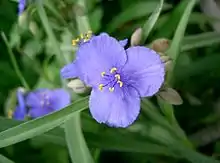| Ohio spiderwort | |
|---|---|
 | |
| Tradescantia ohiensis | |
| Scientific classification | |
| Kingdom: | Plantae |
| Clade: | Tracheophytes |
| Clade: | Angiosperms |
| Clade: | Monocots |
| Clade: | Commelinids |
| Order: | Commelinales |
| Family: | Commelinaceae |
| Subfamily: | Commelinoideae |
| Tribe: | Tradescantieae |
| Subtribe: | Tradescantiinae |
| Genus: | Tradescantia |
| Species: | T. ohiensis |
| Binomial name | |
| Tradescantia ohiensis | |
| Synonyms[2] | |
| |
Tradescantia ohiensis, commonly known as bluejacket[3] or Ohio spiderwort, is an herbaceous plant species in the genus Tradescantia native to eastern and central North America. It is the most common and widely distributed species of Tradescantia in the United States, where it can be found from Maine in the northeast, west to Minnesota, and south to Texas and Florida. It also has a very small distribution in Canada in extreme southern Ontario near Windsor.[4][5][6]
Distinguishing features of the species include glaucous leaves and stems, leaves forming an acute angle with the stems, sepals with hairs lacking glands which are confined to the apex if present at all, and a relatively tall habit (up to about 115 cm). Typical habitats for the plant include roadsides, along railroads, and in fields and thickets. Less typically it can occur in woods, and sometimes along streams. As with many species in the genus, it often forms hybrids with related species where they co-occur. More specifically, at least nine different species are thought to be capable of forming hybrids with T. ohiensis.[7]
Ohio spiderwort has edible flowers and shoots. Flowers and stems can be eaten raw, while the leaves can be cooked. Leaves of the plant are mucilaginous and can be used to soothe insect bites in a similar way to aloe vera.
References
- ↑ NatureServe (30 June 2023). "Tradescantia ohiensis". NatureServe Network Biodiversity Location Data accessed through NatureServe Explorer. Arlington, Virginia: NatureServe. Retrieved 15 July 2023.
- ↑ "Tradescantia ohiensis Raf". Plants of the World Online. Board of Trustees of the Royal Botanic Gardens, Kew. 2017. Retrieved 10 July 2020.
- ↑ USDA, NRCS (n.d.). "Tradescantia ohiensis". The PLANTS Database (plants.usda.gov). Greensboro, North Carolina: National Plant Data Team. Retrieved 14 December 2015.
- ↑ "Tradescantia ohiensis". World Checklist of Selected Plant Families (WCSP). Royal Botanic Gardens, Kew.
- ↑ "Tradescantia ohiensis". County-level distribution map from the North American Plant Atlas (NAPA). Biota of North America Program (BONAP). 2014.
- ↑ Turner, B.L. (2006). Texas species of Tradescantia (Commelinaceae). Phytologia 88: 312-331.
- ↑ Faden, Robert (2000). "Tradescantia ohiensis". In Flora of North America Editorial Committee (ed.). Flora of North America North of Mexico (FNA). Vol. 22. New York and Oxford: Oxford University Press – via eFloras.org, Missouri Botanical Garden, St. Louis, MO & Harvard University Herbaria, Cambridge, MA.
